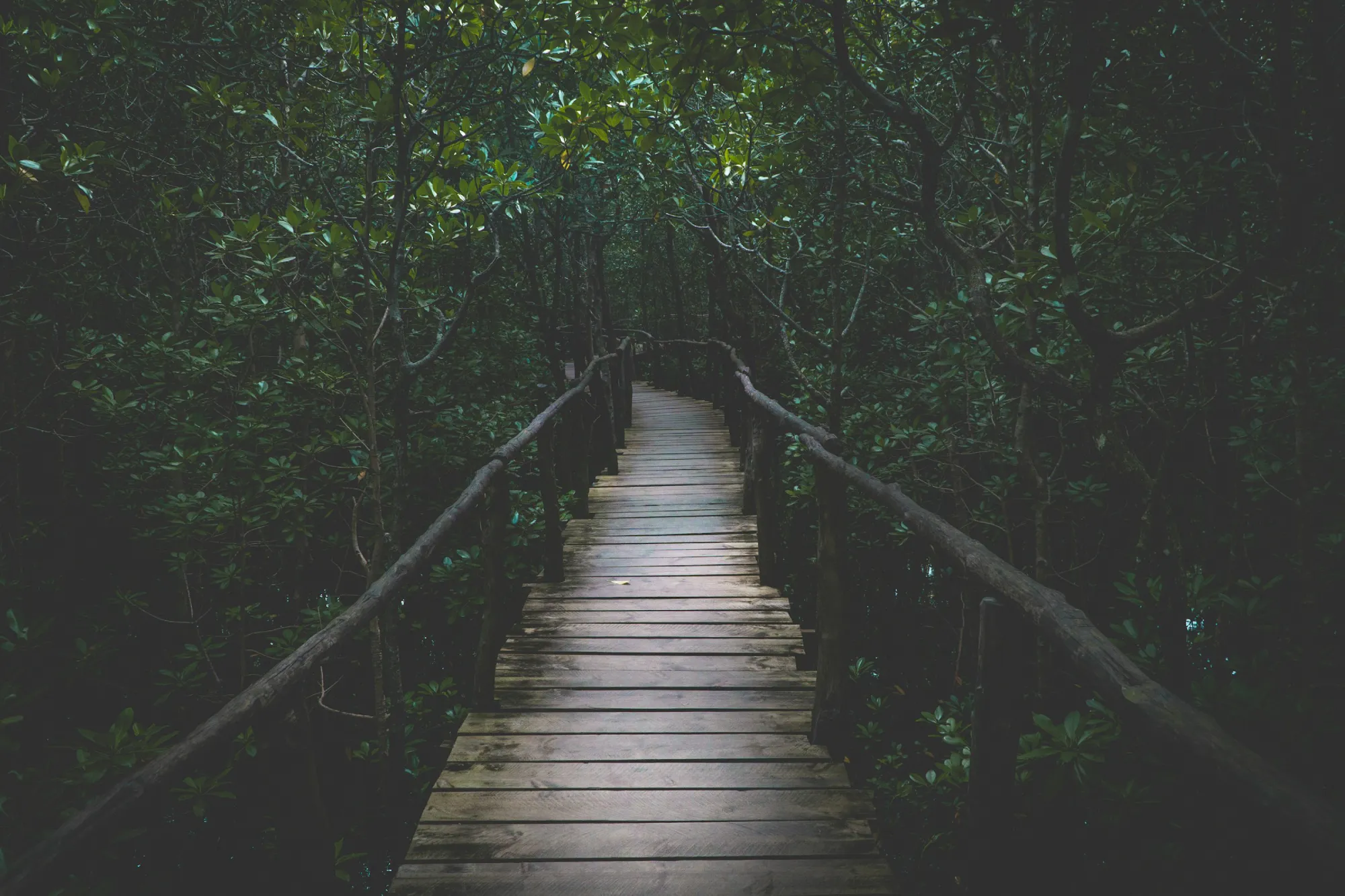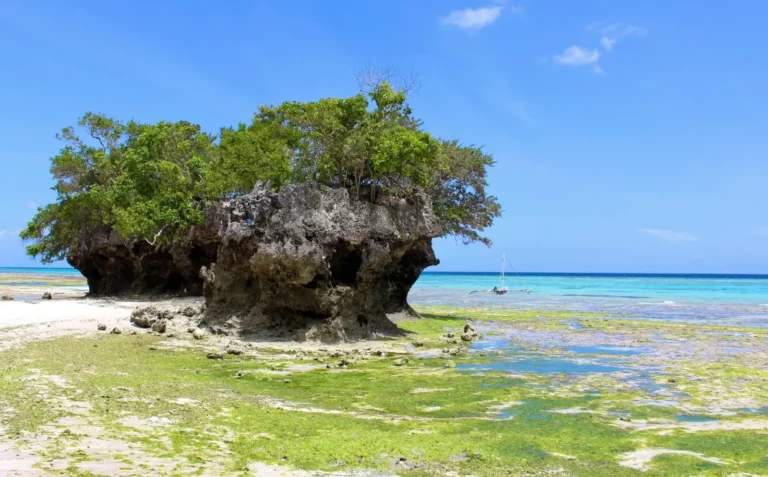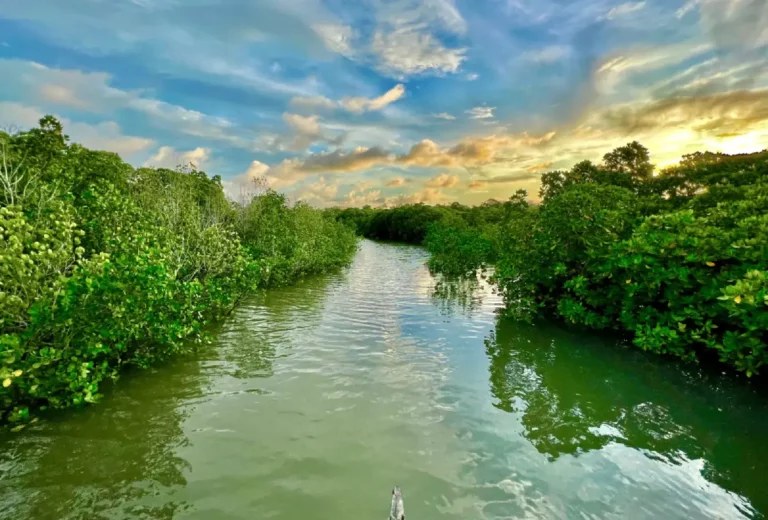10 Unforgettable Encounters in Jozani Forest – Zanzibar’s Green Soul

Table of Contents
When most travelers think of Zanzibar, they picture soft white beaches, the scent of spices in the air, and the historic alleyways of Stone Town. But beyond the shoreline lies a hidden treasure that few venture deep enough to experience — Jozani Forest, the island’s last remaining indigenous forest and its only national park. Tucked into the southeastern region of Unguja (Zanzibar’s main island), this protected area is a haven of rare biodiversity, endemic wildlife, and lush tropical vegetation that has stood for centuries.
Covering roughly 50 square kilometers, Jozani-Chwaka Bay National Park is not just a sanctuary for wildlife — it’s an ecological powerhouse that plays a critical role in Zanzibar’s environmental health. Here, salt-tolerant mangrove forests protect the coastline, swamp forests regulate groundwater levels, and the high-canopy forest shelters creatures found nowhere else on Earth, like the critically endangered Zanzibar red colobus monkey.
Designated as a UNESCO Biosphere Reserve in 2016, Jozani Forest is one of the best examples of community-based conservation in East Africa. It’s where tourism, science, and local culture intersect to protect and celebrate the natural heritage of the island.
For travelers who want to do more than sunbathe and snorkel, a visit to Jozani Forest offers an immersive experience into the wild, beating heart of Zanzibar. It’s a journey through tangled roots, ancient canopies, and the calls of creatures that have lived here long before the world knew the name “Zanzibar.”
Let’s explore what makes Jozani Forest one of the most important — and unforgettable — destinations on the island.
A Brief History of Jozani Forest

Jozani Forest has a fascinating backstory rooted in conservation. Originally declared a forest reserve in the 1960s to protect its unique biodiversity, it gained national park status in 2004, encompassing about 50 square kilometers. But its importance extends beyond its official boundaries.
In 2016, UNESCO designated the area as the Jozani-Chwaka Bay Biosphere Reserve — a move that recognizes not only its ecological significance, but also its role in supporting sustainable development and local livelihoods. This makes it a flagship for eco-tourism in Zanzibar and one of the few places in the world where community-based conservation is thriving alongside tourism.
The Ecology of Jozani Forest
Jozani Forest is a vibrant tapestry of interwoven ecosystems that showcase the remarkable biodiversity of Zanzibar. Though the forest itself covers around 50 square kilometers, its ecological impact extends far beyond its borders as part of the larger Jozani-Chwaka Bay Biosphere Reserve. This protected area includes a diverse range of habitats — coastal forest, swamp forest, mangroves, salt flats, and even the seagrass beds of Chwaka Bay — each playing a vital role in supporting life on the island.
The forest is home to over 100 species of trees and a wide array of undergrowth, including ferns, vines, and medicinal plants used in traditional healing. Towering hardwoods like mahogany and eucalyptus form a dense canopy that shelters smaller plants and countless species of insects, birds, and mammals. The swamp forest areas, which are seasonally flooded, are particularly important for regulating groundwater levels and preventing saltwater intrusion into freshwater supplies — a growing concern in island ecosystems affected by climate change.
Jozani’s unique location at the transition between land and sea gives rise to rich ecological interactions. Its mangrove forests are crucial breeding grounds for fish and crustaceans and act as natural barriers against coastal erosion. These mangroves also sequester large amounts of carbon, making them essential in the fight against global warming.
In addition to the plant and tree diversity, Jozani supports a complex web of animal life. Many species found here are either rare or entirely endemic to Zanzibar, making the forest an irreplaceable stronghold for island biodiversity. The interconnectedness of its ecosystems — forest, swamp, and marine — means that any disruption in one area can have a ripple effect across the whole environment, further emphasizing the need for conservation.
For scientists, conservationists, and eco-conscious travelers alike, Jozani offers a living classroom that highlights the delicate balance of tropical island ecosystems and the urgent need to protect them.
The Endemic Zanzibar Red Colobus Monkey

The crown jewel of Jozani Forest is undoubtedly the Zanzibar red colobus monkey (Piliocolobus kirkii), one of the rarest and most distinctive primates in the world. Endemic to Zanzibar, this species is found nowhere else on Earth, and its survival is closely tied to the conservation of Jozani Forest and surrounding habitats. With their striking reddish-brown backs, white bellies, black limbs, and expressive faces framed by a halo of white hair, these monkeys are both photogenic and fascinating to observe.
The Zanzibar red colobus population is estimated at just under 6,000 individuals, with around two-thirds living within or near the Jozani-Chwaka Bay area. They are classified as Endangered on the IUCN Red List due to habitat loss, fragmentation, and occasional conflict with humans — though significant conservation progress has been made in recent decades thanks to eco-tourism and community engagement.
Unlike many primates, red colobus monkeys have a highly specialized and complex diet, feeding mostly on young leaves, unripe fruit, flowers, and seeds from over 70 known plant species. They even consume charcoal and clay to neutralize toxins from certain plants — a behavior that highlights their deep adaptation to their environment. Their multi-chambered stomachs function similarly to those of cows, allowing them to ferment and digest cellulose-rich plant matter efficiently.
Zanzibar red colobus monkeys are highly social and live in large, loosely structured groups that can include up to 50 individuals. Within these groups, females tend to stay with their natal troop for life, while males migrate between groups. Their vocalizations include warning calls, contact sounds, and alarm cries — a constant chatter that fills the forest canopy.
One of the most remarkable aspects of visiting Jozani Forest is how habituated these monkeys are to humans. Years of responsible eco-tourism have made it possible to observe them from just a few meters away, without cages or barriers, in their natural habitat. This makes for an incredibly intimate and memorable wildlife experience — especially for photographers and families.
The Zanzibar red colobus is more than just a mascot for the park; it’s a living symbol of conservation success and an enduring reminder of what’s at stake. Protecting this species means preserving the entire forest ecosystem they depend on, and in turn, supporting the communities that live alongside them.
Other Wildlife in Jozani Forest

While the red colobus is the headline act, Jozani Forest is far from a one-monkey show. The forest is also home to several other primates like Sykes’ monkeys and the Zanzibar bush baby, a small nocturnal creature with huge eyes and an eerie nighttime call.
Small antelopes known as duikers quietly browse in the underbrush, and you might catch a glimpse of African civets or mongoose darting across the trail. Bird lovers will find plenty to marvel at too, as the forest is a paradise for species such as the Fischer’s turaco, African paradise flycatcher, and the crowned hornbill.
Reptiles and amphibians, including chameleons, skinks, frogs, and harmless snakes, thrive in this humid ecosystem. And in the mangrove sections of the park, fiddler crabs and mudskippers add to the strange and beautiful complexity of life.
The Mangrove Boardwalk
One of the most popular features of the Jozani Forest experience is the elevated boardwalk that winds through a pristine mangrove swamp. These salt-tolerant trees are crucial to coastal protection, acting as natural barriers against erosion and storms while providing nurseries for countless marine species.
Walking the boardwalk offers an intimate look into a habitat rarely seen by casual visitors. The tangle of roots beneath your feet, the birds fluttering overhead, and the smell of the ocean creeping into the forest make it a sensory-rich highlight of any visit.
Guided Tours and Nature Walks
Jozani Forest is best experienced through a guided tour, and the local guides are deeply knowledgeable about the ecology, folklore, and conservation challenges of the park. Tours usually last around one to two hours and are conducted at a relaxed pace, with plenty of time for photography and questions.
You’ll walk under towering mahogany, ficus, and eucalyptus trees, learn how traditional medicine is derived from local plants, and gain insight into the delicate balance that keeps this ecosystem alive.
For photographers and wildlife lovers, early morning or late afternoon visits are the most rewarding. The soft light filters through the canopy, animals are more active, and the forest hums with life.
Eco-Tourism and Community Involvement
One of the most impressive aspects of Jozani Forest is how closely it’s tied to the local communities. The forest is managed by the Department of Forestry and Non-Renewable Natural Resources, but its success is also thanks to the surrounding villages who benefit directly from tourism revenues.
A portion of every entrance fee goes toward community development projects — schools, clinics, clean water, and alternative livelihoods. This has created a sense of shared ownership and pride, reducing illegal logging and poaching and increasing support for conservation.
It’s a textbook example of eco-tourism done right: where protecting nature also means improving lives.
Practical Information for Visiting Jozani Forest
Location and Access
Jozani Forest is about 35 kilometers southeast of Stone Town. It’s easily accessible by car, taxi, or as part of a guided day tour that often includes other stops like the butterfly center or spice farms.
Opening Hours and Entrance Fees
The park is open daily from 7:30 AM to 5:00 PM. Entrance fees are $10 for foreign adults, with discounted rates for children and residents. Guided tours are included in the price, and no advanced booking is needed.
What to Bring
Wear light, breathable clothing and comfortable walking shoes. Bring water, sunscreen, insect repellent, and a camera. While the trails are relatively easy, the forest can be humid, so be prepared for warm conditions.
Respect the park rules: don’t feed the animals, don’t stray off the trail, and follow your guide’s instructions. Conservation here depends on responsible tourism.
Combining Jozani with Other Zanzibar Activities
While Jozani Forest is worth the visit on its own, its location makes it easy to pair with other enriching activities that showcase Zanzibar’s natural and cultural diversity. Many travelers choose to make a full day of it by combining a morning forest hike with nearby attractions. This approach not only maximizes your time but also deepens your understanding of Zanzibar’s ecosystems and traditions.
One of the most rewarding additions to your Jozani itinerary is the Zanzibar Butterfly Centre, a community-run conservation project located just a short walk or a few minutes’ drive from the park entrance. It’s an unexpected yet powerful stop that transforms your idea of what a butterfly garden can be.
Visit the Zanzibar Butterfly Centre

Set against the backdrop of a lush tropical garden, the Zanzibar Butterfly Centre (ZBC) is more than a pretty place to see colorful insects fluttering around. It’s one of the largest butterfly enclosures in East Africa and a pioneering project in Zanzibar’s eco-tourism and environmental education efforts.
The center operates as a sustainable, community-led initiative that supports local farmers through butterfly farming. Villagers are trained to rear native butterfly species in environmentally friendly ways, and the center purchases the pupae to display in its controlled garden habitat. This provides an alternative income stream to activities like logging or charcoal production, helping protect the very forests that butterflies (and red colobus monkeys) depend on.
Once inside, visitors step into an enclosed garden teeming with life. Dozens of species — including the vivid blue Papilio nireus and the intricate Danaus chrysippus — glide around you, feeding on flowers, basking on sunlit leaves, and occasionally landing on outstretched hands or camera lenses. It’s a peaceful, meditative experience and a brilliant photo opportunity for nature lovers and families alike.
Perhaps most impactful is the educational element. Knowledgeable guides walk you through every stage of the butterfly’s lifecycle, from egg to caterpillar to cocoon to adult, drawing connections between butterfly health and forest conservation. You’ll come away with a deeper appreciation not only for these delicate creatures but also for the broader ecological web they’re part of.
And because the project directly benefits the surrounding villages, your visit contributes to grassroots conservation — one butterfly at a time.
Add a Spice Farm Tour
After immersing yourself in the island’s wild forest and delicate insect world, you can shift gears and explore one of Zanzibar’s most iconic traditions: spice farming. Spice tours are offered throughout the island, but several are conveniently located within a short drive from Jozani.
These guided experiences walk you through working spice plantations where you’ll see, touch, and smell fresh cloves, nutmeg, cinnamon, turmeric, vanilla, lemongrass, and cardamom — the same spices that earned Zanzibar its centuries-old nickname, “The Spice Island.” Guides often enhance the tour with fun sensory games, fruit tastings, and cultural insights into how these spices have shaped Zanzibar’s economy and cuisine.
It’s a multi-sensory journey that contrasts beautifully with the sights and sounds of the forest.
Stop at Paje or Jambiani for Beach Time
After your inland explorations, what better way to unwind than with a cool breeze and soft sands? The southeastern coast of Zanzibar is just a short drive from Jozani Forest and is home to some of the island’s most beautiful beaches.
Paje and Jambiani are two popular spots that offer a relaxed, laid-back vibe compared to the busier north. Paje is famous for kitesurfing and vibrant beach cafés, while Jambiani exudes rustic charm and serenity, making it perfect for a lazy afternoon swim or seafood lunch by the shore.
Whether you’re seeking adventure or tranquility, this coastal stretch offers a perfect bookend to your nature-filled morning.
Other Nearby Stops to Consider
- The Seaweed Center in Paje: A women-led initiative where you can learn about sustainable seaweed farming and even make your own organic soap.
- Makunduchi Village: For those interested in cultural tourism, this traditional southern village offers insights into Swahili customs and rural life.
- Michamvi Peninsula: Just northeast of Jozani, this quieter area features mangrove walks, hidden beaches, and the famous sunset spot at The Rock Restaurant.
Combining Jozani Forest with these activities creates a full-day journey that blends nature, culture, and relaxation — the essence of what makes Zanzibar such a rich and rewarding destination.
Conservation Challenges and the Future of Jozani Forest
Despite its protected status, Jozani Forest faces ongoing challenges. Population pressure, agricultural encroachment, and climate change all threaten the delicate balance of the ecosystem. The rise in tourism also brings risks of overcrowding and habitat disturbance.
But there’s reason for hope. Thanks to a strong eco-tourism model and engaged local communities, Jozani remains one of the best-preserved natural areas in East Africa. Ongoing reforestation projects, educational outreach, and scientific research are helping secure its future.
The forest has become a symbol of what’s possible when conservation, culture, and tourism work hand in hand.
Why Jozani Forest Belongs on Your Zanzibar Itinerary
Jozani Forest might not be the first thing that comes to mind when planning a trip to Zanzibar, but it absolutely deserves a spot on your itinerary. It offers a side of the island that many travelers miss — one rooted in biodiversity, conservation, and the raw beauty of nature.
It’s not just the only national park in Zanzibar; it’s the island’s last remaining stretch of indigenous forest, home to species you won’t find anywhere else in the world, like the Zanzibar red colobus monkey. Whether you’re a nature lover, photographer, or simply curious traveler, walking under the towering canopy of Jozani offers a refreshing change of pace from the beach and a chance to experience the island’s true wild side.
The park is easy to access, doesn’t require a full day, and pairs perfectly with other nearby activities like the Zanzibar Butterfly Centre or a spice farm tour. It’s affordable, family-friendly, and led by knowledgeable local guides whose insights add meaning to the walk.
But most importantly, your visit supports community-based eco-tourism and helps protect this fragile ecosystem. For travelers looking to make meaningful, responsible choices — Jozani Forest is an essential stop.





